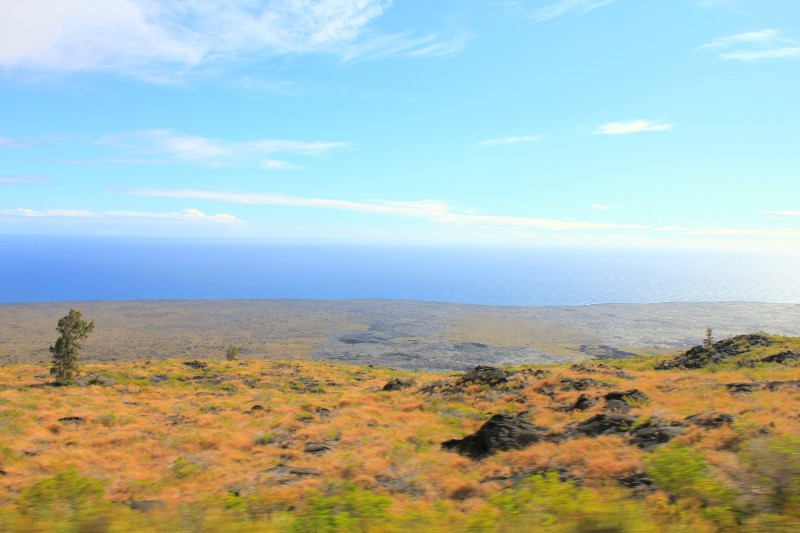
Southwest of Kilauea Volcano lies a vast and mysterious land. Most guidebooks offer little to say about it and access to this place is extremely limited. Indeed, inhospitable conditions, lack of water, extreme heat, and scarcity of plant life lead most people to overlook this place all together. This is big island’s vast and desolate Ka’u Desert.
This desert exists because of a rain shadow effect from Kilauea. The mountain pushes up the incoming clouds forcing them to cool and drop their contents on Volcano’s rain forest just 4 miles away, leaving the desert high and dry. Ka’u is not technically a true desert, being that it receives more than 39in of rainfall per year. The rain that falls in Ka’u is acidic, having come from clouds that mix with the rising volcanic gasses. This acid rain, combined with the heat, lack of nutrients, and pourous earth, make most of the Ka’u desert a lifeless place. Plants here are few and far between, but trees that do manage to grow here may be hundreds of years old.
Thankfully, rain is an uncommon occurrence in Ka’u. There are no roads across this desert, but hiking trails criss-cross its face within the national park. There are three primary ways to access the desert from paved roads.
Your best view of the Ka’u desert will come from the top of the 1600 foot cliffs at the end of Hilina Pali road inside the Volcano Park. From here on a clear day you can see all of Ka’u and more than 30 miles down the coastline. There are two trails that take off from here. One goes down the pali (cliff face) and heads for the ocean, the other runs along the top of the pali and into the heart of the desert.
Most people enter the Ka’u desert from the trailhead along the highway 9.2 miles down the road from the park entrance. This is footprints trail, deriving its name from footprints preserved in the surface rock a mile down the trail. These footprints are from the 1790 eruption, one of the most devastating eruptions in recent history, which covered the area in a blanket of hot ash. A group of Hawaiian warriors were marching through the desert when the eruption began. More than 80 warriors died from breathing the ash, and these footprints were supposedly made by them as they fled.
The third way into the desert is much farther south between the 46 and 47 mile marker on the highway. Here there is a small parking pullout and an old unmaintained access road that leads to one of Ka’u desert’s most stunning features: an 8 mile long, 60 foot wide, 60 foot deep chasm called The Great Crack.
The Great Crack is huge. It’s impossible to appreciate its full size unless you’re standing right on the edge. Stretching across the desert and out of the park to the south, this fissure is filled with lava tubes. The crack is about 2 miles from the highway through dry scrub and lava country.
Ka’u desert is huge and starkly.beautiful. Most visitors and even locals tend not to give this dry, desolate land a second thought, but for the adventurous few, Ka’u holds many treasures.
